Philadelphia YIMBY’s recent site visit has observed that the Painted Bride Art Center still stands shrouded at 230 Vine Street in the Old City section of Center City. The building, adorned with artist Isaiah Zagar’s whimsical mosaic, will be topped by a 64-unit residential extension.
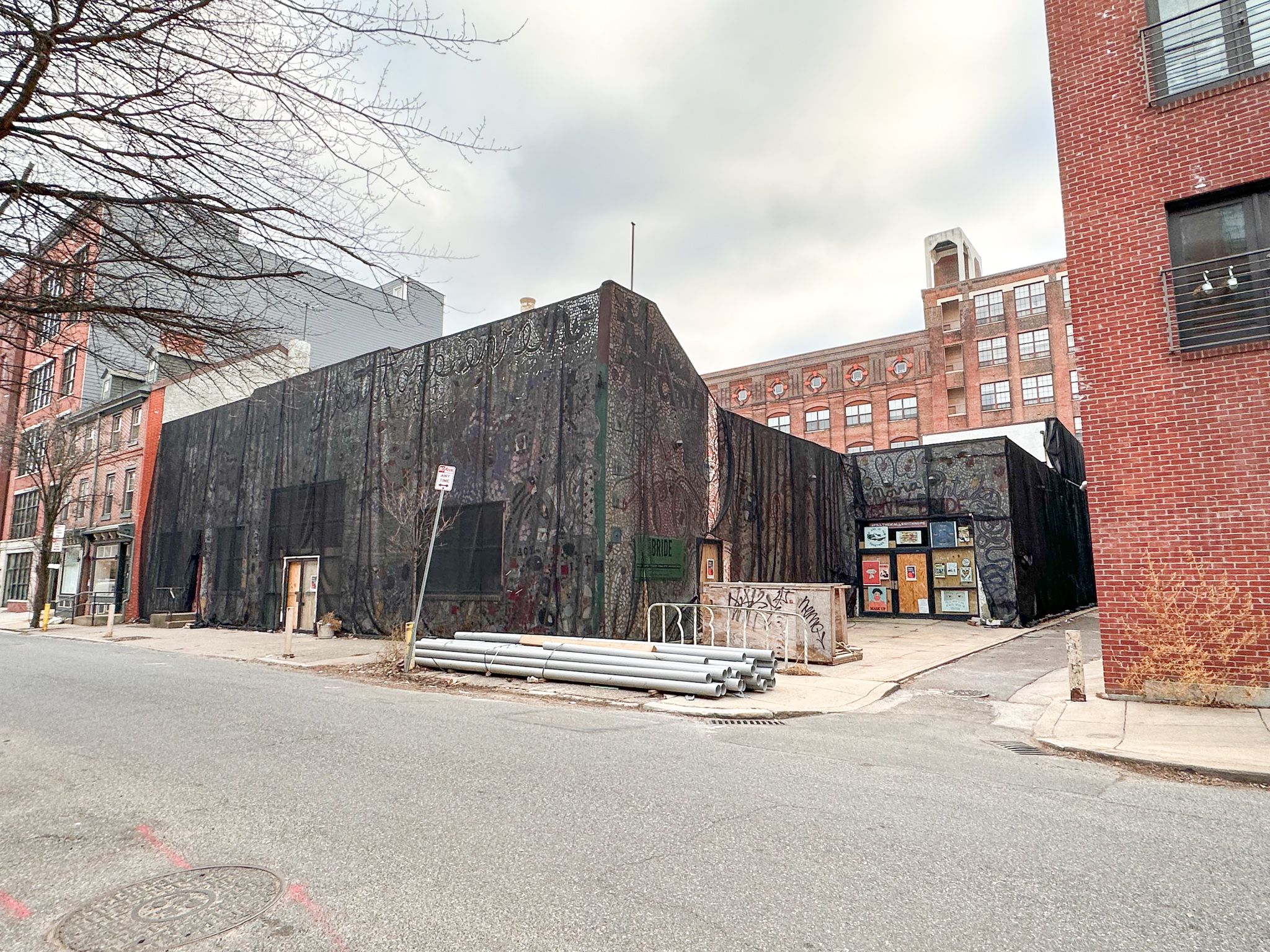
230 Vine Street. Photo by Jamie Meller. February 2023
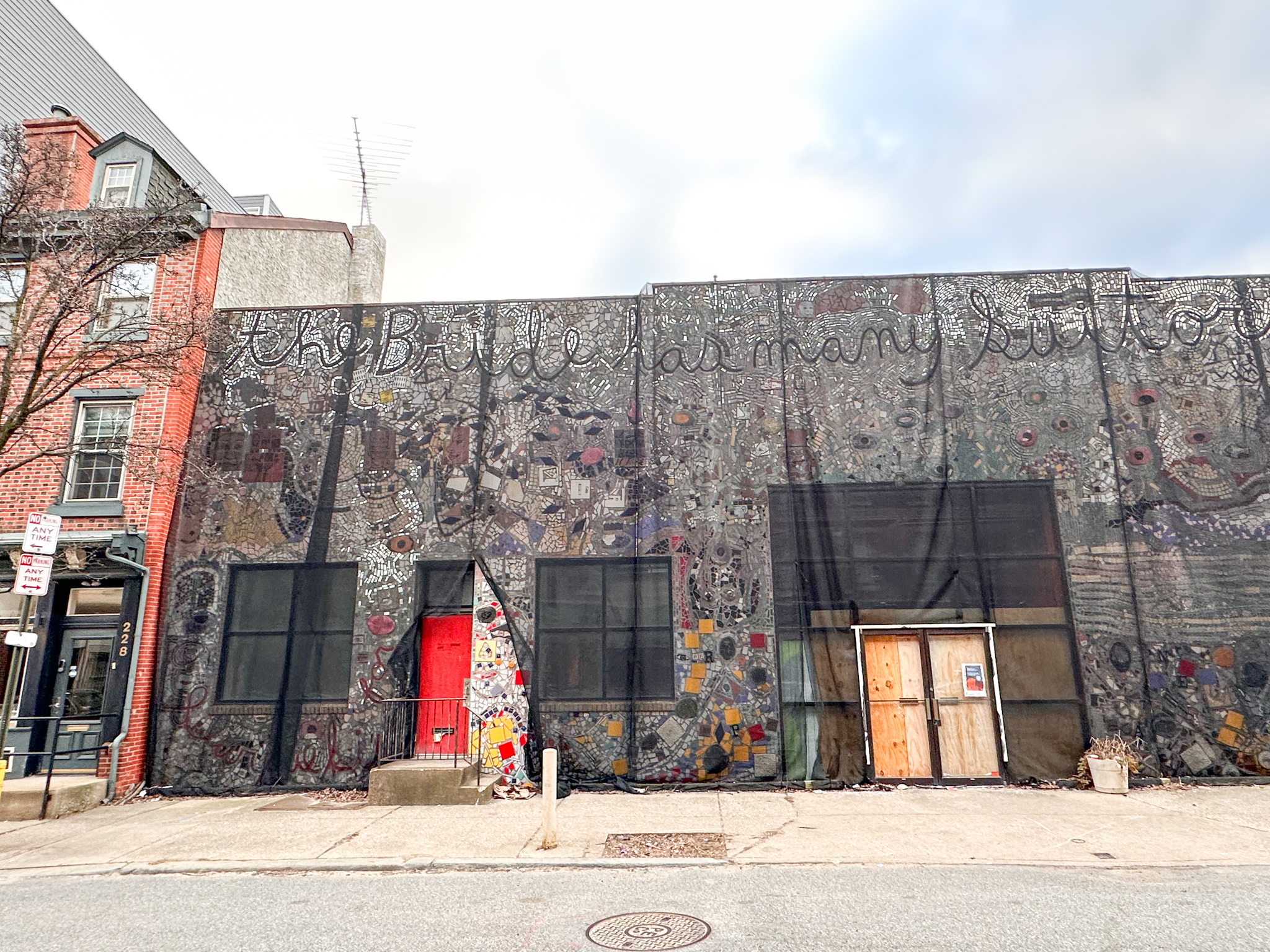
230 Vine Street. Photo by Jamie Meller. February 2023
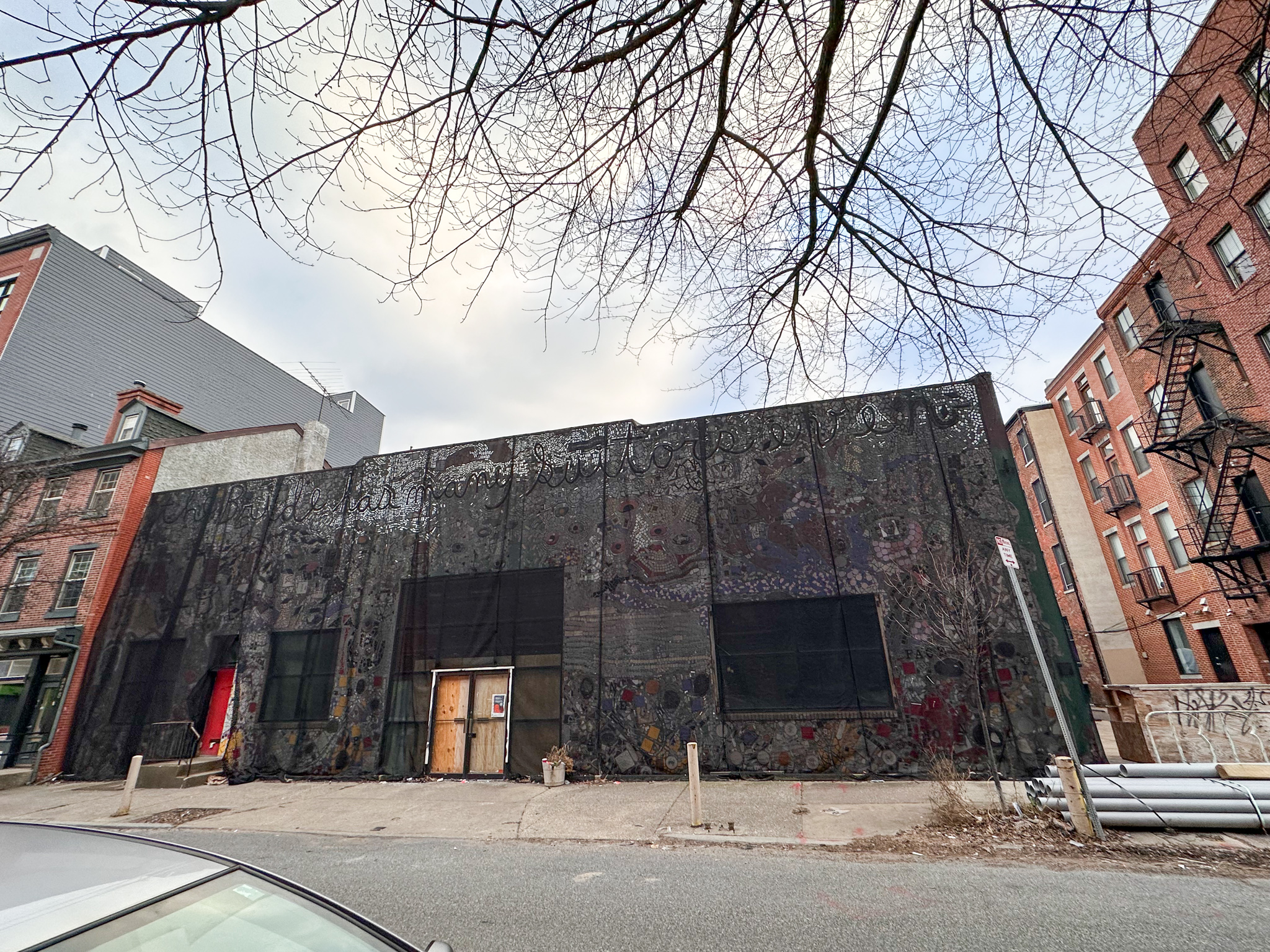
230 Vine Street. Photo by Jamie Meller. February 2023
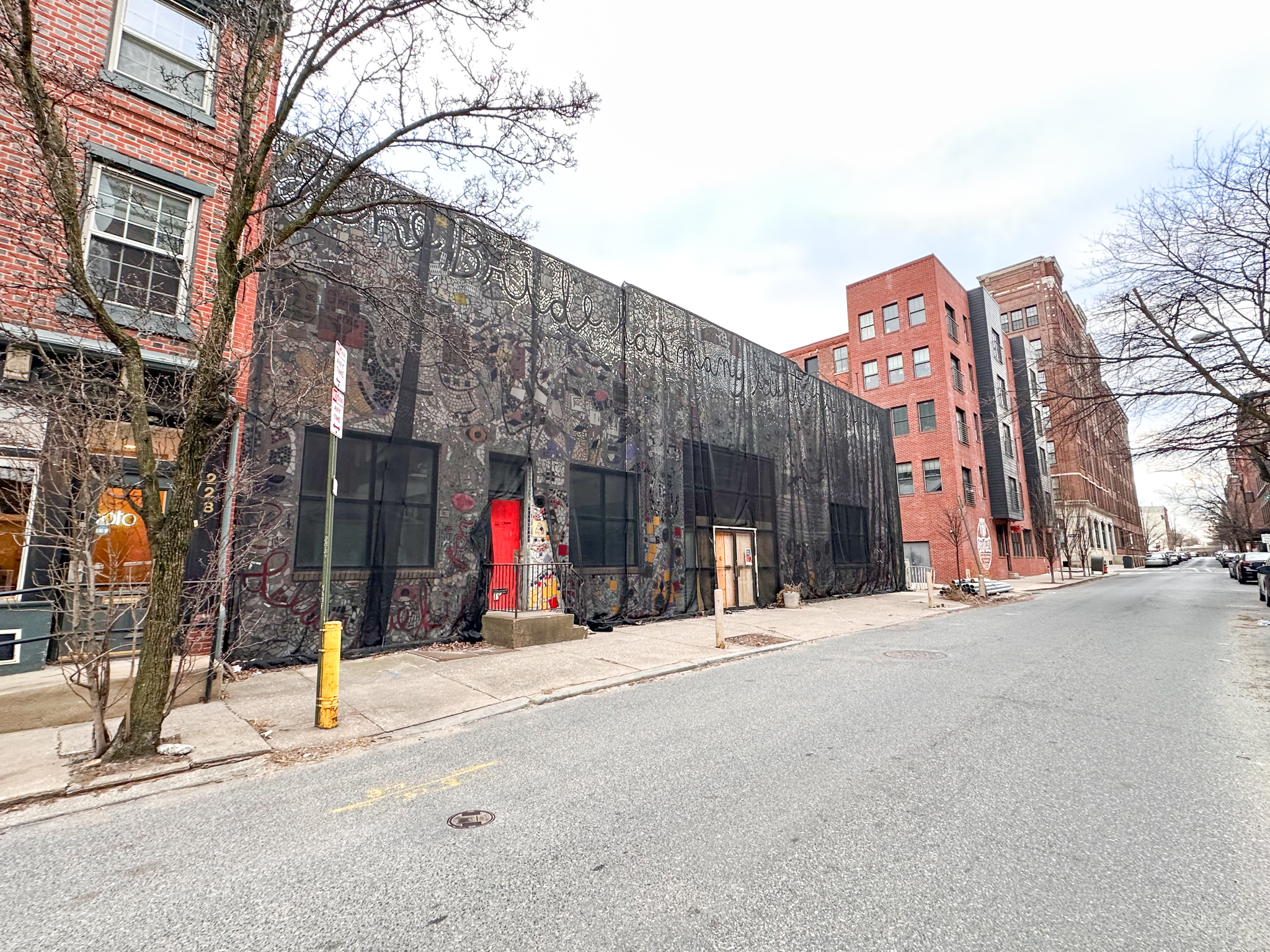
230 Vine Street. Photo by Jamie Meller. February 2023
The Painted Bride Art Center is a gallery and performance space that was founded in 1969 and moved to its current Old City location in 1982. The official website describes the organization as one that is “committed to supporting artists, fostering diversity and inclusivity, and providing a safe and welcoming environment for artists, audiences and communities to explore the human experience and examine issues of social justice.”
While the venue has been a staple of the Philadelphia arts scene for over half a century, to the average pedestrian, its facility at 230 Vine Street is most notable for its colorful, playful 7,000-square-foot mosaic created by artist Isaiah Zagar. Zagar, aged 82 at the time of this writing (turning 83 on April 1st), is a Philadelphia-based artist best known for his phantasmagorical mosaics that adorn various sites throughout the city, including Magic Gardens on South Street.
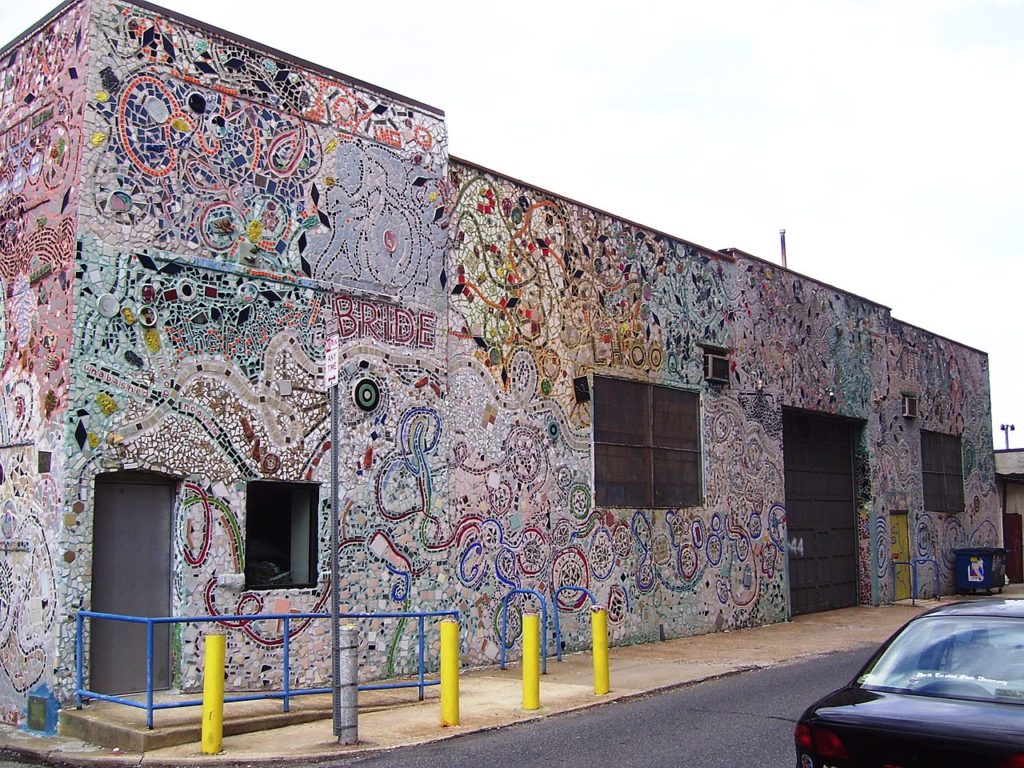
The Isaiah Zagar mosaic at Painted Bride Art Center at 230 Vine Street. Credit: Beyond My Ken via Wikipedia
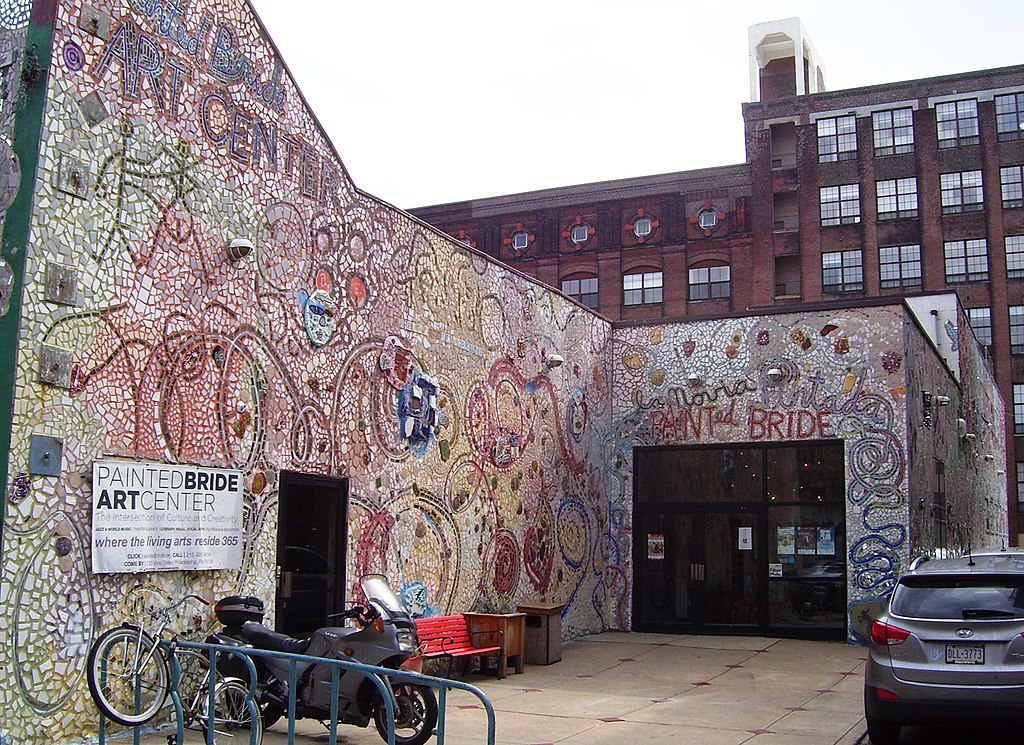
The Isaiah Zagar mosaic at Painted Bride Art Center at 230 Vine Street. Credit: Beyond My Ken via Wikipedia
In 2017, the building and its mosaic came under threat of destruction when the heads of the Art Center announced their intent to sell the building. The building itself would be demolished and replaced with a five-story, 16-unit condominium project that was planned to rise 65 feet tall, span 54,000 square feet, and include 16 parking spaces and a roof deck. According to the Center’s representatives, the sale would be used to fund the venue’s affiliated artists and art programs. At the time, executive director Laurel Raczka shared the following as part of a statement:
“We are imagining a future that gives us the financial and creative capacity to continue our important work. We will do this by selling our primary asset – our building at 230 Vine Street – in order to secure a flexible source of capital for investment. With the proceeds of the building sale, we will ensure that the Bride can fulfill its central mission – supporting artists.”
The proposal came under fire from numerous directions, including preservationists, neighbors, and art aficionados. While YIMBY is typically wary of development obstructionism, especially when non-historic buildings are involved (in 2018, the Historical Commission voted against granting a historic designation to the building at 230 Vine Street). However, in this case we could see the merit in opposing the development, especially when an obvious, and oft-advocated by Philly YIMBY, solution has been there all along: preserve the existing building’s exterior and build the new development above.
Fortunately, this is precisely the course of development the project team settled for. After discussions with preservation proponents, architect and developer Shimi Zakin of Atrium Design Group released a plan that incorporates the existing building and its mosaic as the base for a 64-unit apartment building.
Leaving the street-facing mosaic intact, the proposal would renovate the interior portion of a building and raise its total height to seven stories and 85 feet, 20 feet above the district’s existing zoning limit. Preserving the integrity of the original facade, the vertical extension is articulated as an independent object, where a rectangular mass is “suspended” via a discreet reveal above the original roof line and perches on angled columns at the corner.
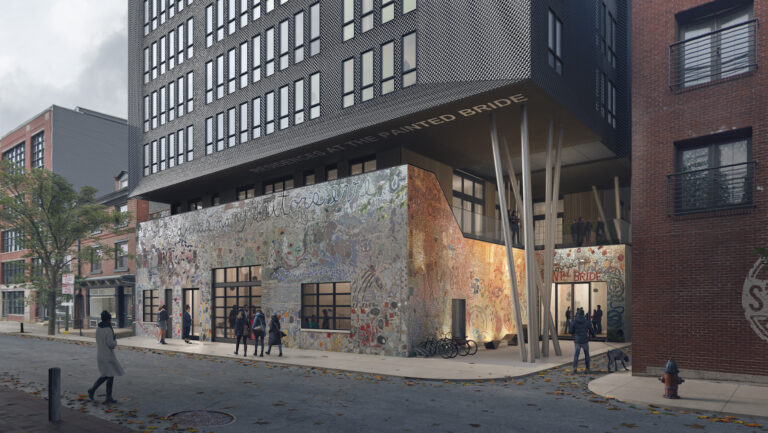
230 Vine Street. Rendering credit: Atrium Design Group
Further strengthening the addition’s sculptural appearance is a chamfered street-facing facade, where a regular grid of narrow windows, with a loggia at the pinnacle, is set within a picture frame-like surround. Although the vertical addition appears solid from the street, its interior would feature a courtyard that would allow for slim, light-filled floor plates while offering an elevated green space for the residents.
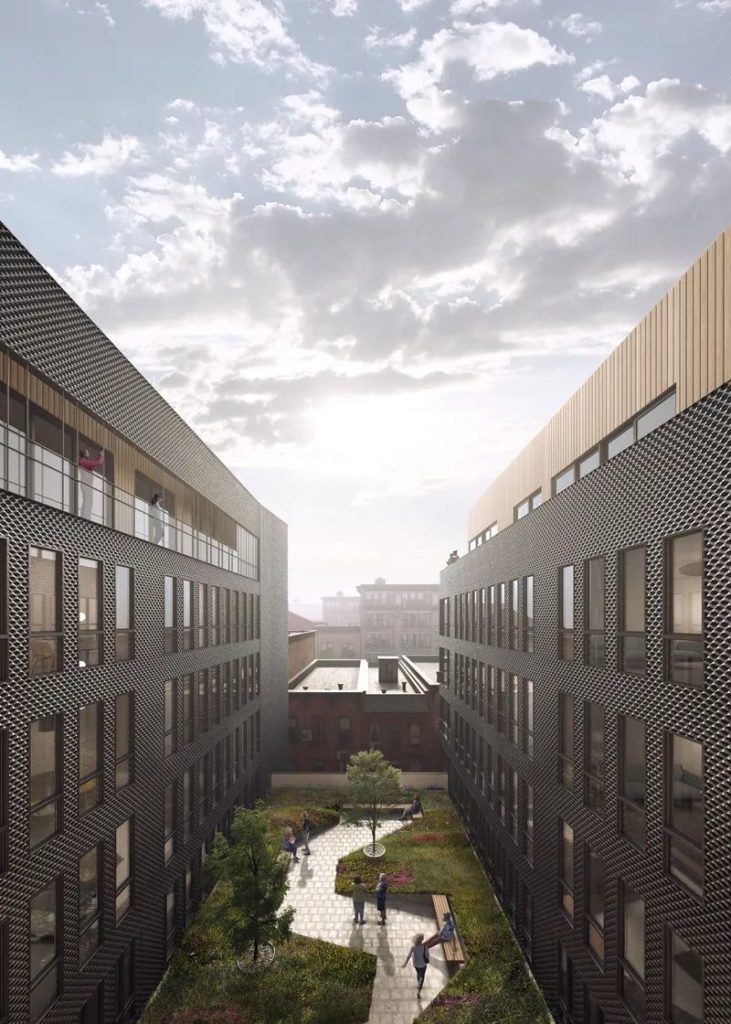
230 Vine Street. Rendering credit: Atrium Design Group
According to an Inquirer report from late 2021, the resolution generated a good deal of mirth both from the project backers and the artist himself. The report quotes Zakin calling the project “an amazing collaboration between art and architecture, art and development” and expressed delight that “the city is seeing eye to eye with us on this great design.” Reportedly, Zagar, the artist, was “screaming with happiness” about initially hearing the news and said that “now we need to work.” Emily Smith, executive director of the nonprofit arts group Philadelphia’s Magic Gardens, is quoted saying that the proposal “makes so much sense” and “feels like such a relief.”
Indeed, the design resolution is winsome for everyone involved. The community retains its outdoor artwork and gains a distinctive architectural addition. Painted Bride Arts Center maintains its incoming revenue. The number of residential units gains a significant bump, boosting the city’s tight housing stock.
All of these positive benefits would be feasible only with zoning variances that would allow the structure to extend above the current height limit. However, certain local groups have already launched a not-in-my-back-yard campaign and call for a reversion to a low-rise, lower-density townhouse plan.
Namely, opposition lawyers allegedly argue that “alternative, shorter designs could also preserve the mosaic, such as townhouses behind a freestanding mural.” However, they fail to address how a townhouse enclave could possibly be laid out upon a tight site hemmed in by largely solid wall on three sides.
The existing building, which rises around 20 feet high, is ideally suited to be re-purposed as a base for a mid-rise development, where it can hold commercial space, a tall-ceiled lobby and amenities, or service functions. Apartments would rise above, unimpeded by the existing wall.
By contrast, townhouses are, by definition, a low-rise typology that must have windows on the lower floors. However, placing townhouses at the site would either require grafting them into the near-windowless existing wall, possibly cutting apertures into the endangered mosaic, or placing them behind the wall altogether, which would preserve the artistic artifact but block the lion’s share of sunlight and views for the houses’ crucially important two lower floors.
In other words, unless we are missing some absolutely ingenious and possibly physics-defying solution, the combination of townhouses and mosaic preservation simply does not work in any realistic way. Stating otherwise, especially without offering any specifics on the suggested design approach, shows either a fundamental lack of understanding of basic design principles, or wishful thinking that it will all work out somehow if they insist on it strongly enough.
While we sympathize with the original push to preserve the existing exterior, at this point, any opposition to the project would be pure obstructionism, where marginal (arguably negligible) benefit to the neighborhood’s built fabric would be eked out at the expense of funds for the Arts Center, housing supply, distinctive architecture, and possibly even the mosaic itself, which once again may face the wrecking ball if a shorter vertical extension would be deemed infeasible.
We look forward to further development at this project that exemplifies what could be achieved through careful design that incorporates the positive aspects of an existing structure with new construction.
Subscribe to YIMBY’s daily e-mail
Follow YIMBYgram for real-time photo updates
Like YIMBY on Facebook
Follow YIMBY’s Twitter for the latest in YIMBYnews

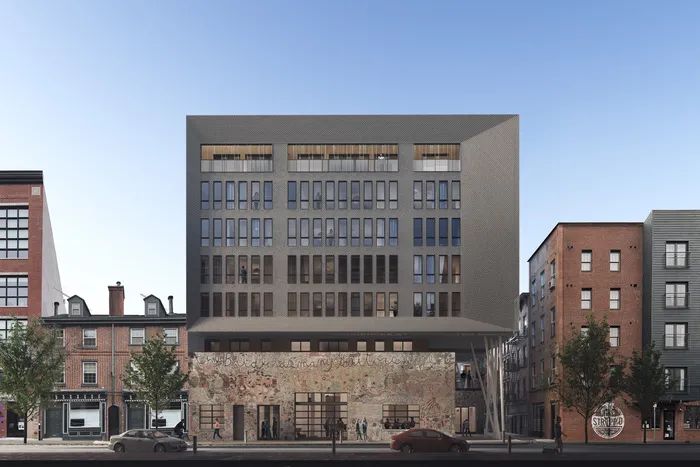
This developement should be allowed to go forward as pictured and not stopped by a handful of neighbors.
Nope
Steve, agreed but looks like a lost cause thanks to “neighborhood opposition,” which we all know is the squeaky wheel gets the grease even though the silent majority supports this.
Agreed Steve. The latest proposal is a lose-lose. Shimi Zakin’s most recent plan calls for demolishing the former arts center and its mural and constructing a six-story 65-foot-tall building with 110 short-term rental units, a first-floor restaurant, and two roof decks. The development needs zoning exceptions for the roof decks which will be considered at ZBA’s June 2023 meeting, but otherwise meets code.
The objecting neighbors lose because Zakin’s latest plan has the highest density proposed to date (e.g., 110 units), with transient short-term renters at that. They get no off-street parking. Objecting neighbors also lose the mural, a neighborhood highlight. However, they do get their wish for a 20 foot decrease in building height (65 vs. 85 feet). The arts community, artist Isaiah Zagar, Magic Gardens (who agreed to restore and maintain the mosaic), developer and owner Shimi Zakin (who very much wanted to preserve the mural), preservationists, neighbors, tourists and many others lose an iconic and irreplaceable piece of art. I add that I too am a loser vis-a-vis the artwork.
All for 20 feet.
This design is dead, FYI. The neighborhood’s position has always been that we would like to save the mosaic, but with a building built to the code. The judge in the appeal by the owner of Chocolate Works agreed with the neighborhood that the developer showed no reason why he could not build within the code. He gave no evidence that the economics of the project could not work at 65′, nor was he willing to discuss possible compromises, both directly with us nor with Alan Domb volunteering to be a mediator.
I know that the people in the neighborhood will miss the mosaic, though it hasn’t been visible for several years, being under a shroud as the facade failed multiple L & I inspections.
As I noted above, the problem is that this is NOT the majority view but rather the perspective of just a few that have the time and energy fighting something the rest of us want but we are just too busy living our lives. It strains credulity to claim the building could be saved and yet the project limited to 65 feet. As the author notes above, a “physics-defying solution” is not realistic.
I agree with Steve and with Isaiah Zagar. The apartment design is brilliant and the neighbors will be honored with this. Change is difficult at first.
The 65’ foot zoning height limit was put in place for good reason- this area is the Federal Historic District and immediately adjacent to the Bride are 2 buildings from 1775- the scale of the proposed 85’ twin towers with another 10+’ of pilot house on top is a blight on the Historic District and our history— the neighborhood loves the mosaic and wants to see it preserved and cannot understand why 4 other NEW construction buildings have or are currently being erected on this same block at 65’— is it simply that at 65’ the profit margin of the developer is not as large? Perhaps this developer should sell to someone else who can figure it out!
Again, physics-defying solutions are hard to come by.
I lived across the street for four years. Building this to 85′ would not ruin the neighborhood. It would allow more people to live in the neighborhood. The zoning height limit is completely arbitrary. Urban neighborhoods thrive with a mix of heights.
Sadly not in Philly where NIMBY rules. Frankly, I find it disgusting.
Is this article up to date? Per the Inquirer’s reporting in the last couple of weeks, the obstructionist won their court battle; the developer is now tearing down the Painted Bride and building a by-right plan.
Oh look, you came up with a cute little name for those who did something that you didn’t agree with. The rest of us call them property owners and residents.
No, the article is not up to date. A brief convoluted timeline follows.
2017: Painted Bride’s board sought to divest (i.e., sell its building) from its increasingly costly to maintain — and increasingly valuable — Old City property.
2020: Developer and architect Shimi Zakin of Atrium Design Group had the property under sale agreement for $4.85M. His initial plan called for the demolition of the Arts Center and Isaiah Zagar’s iconic mixed-medium mosaic “Skin of the Bride”, and the construction of 16 65-foot tall condos. Philadelphia issued a zoning permit for demo of the Painted Bride building (and mural) and construction of the condos. However, many (including near neighbors, the arts community, and Isaiah Zagar himself) objected to the mural’s demo, and the building was quickly nominated as historic. However, the nomination was not successful. After Orphans Court decreed that the arts building (and mural) could not be razed, Commonwealth Court overturned that ruling, meaning that the building (and mural) could indeed be demoed.
2021: Zakin’s second proposal (described in detail by YIMBY above) called for an 85-foot tall apartment building with 64 long term rental units (e.g., apartments), 10 short term rental units, a roof deck, an internal courtyard, ground floor commercial space and a small art gallery facing Vine Street, 44 bicycle parking spaces, and 12 auto parking spots. The plan entailed removal of the roof of the existing building and preservation of the existing façade and mural. Philadelphia’s Magic Gardens agreed to restore and maintain the mosaic if the city approved Zakin’s plans. The proposal exceeded the historic neighborhood’s 65-feet height limit and covered more of the lot than allowed under zoning regulations and therefore (unlike the first proposal) needed a zoning variance. ZBA approved Zakin’s plan for a seven-story apartment building that preserves Zagar’s signature mosaic but owners of the nearby Chocolate Works apartment building and some other neighbors appealed the board’s decision.
2022: A Philadelphia Common Pleas Court judge reversed the zoning board’s decision and agreed with Franklin Bridge North Neighbors (a local community group) that the mosaic could be preserved without allowing exceptions to the zoning code.
2023: Owner, developer and architect Shimi Zakin now proposes demolishing the building and its mural and constructing a six-story building with 110 short-term rental units, a first-floor restaurant, balconies, and two roof decks. The development needs zoning exceptions for the roof decks (but otherwise meets code), which will be considered at ZBA’s June 2023 meeting.
Thank you Mr. Mayor
Sounds like local museums are not interested in selecting the best pieces of the Mosaic for incorporation in their facilities. Having a by right plan in place, the developer is ready to to start construction.
Well the “property owners and residents” as Steve likes to refer to them have once again showed that close-minded NIMBY attitudes all too often win out in this city. So it’s a shameful goodbye to this iconic building. SAD!
Sorry Steve is correct, it is “Mayor Kenny” to whom I should have addressed my disappointment. FYI: I too am a property owner and resident, but I’d actually like to see our neighborhood grow and thrive. Oh well.
When you’re walking along the street, what will you see. An amazing mural that will give you pause? Or another run of the mill apartment building and storefronts. Height doesn’t matter to the pedestrian and tearing down something that’s iconic is in the spirit of history. Can’t believe that “historic district” height limit has that much weight. Also, too bad about Mayor Kenney.
NIMBYS ruin everything. Hope you obstructionists are happy. You should be ashamed. Huge L to lose this project as proposed.